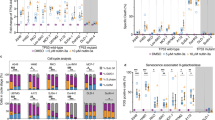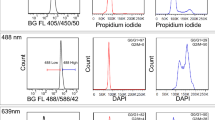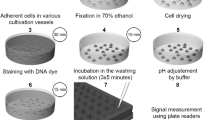Abstract
Flow cytofluorimetric techniques, using acridine orange fluorescence to measure RNA and DNA simultaneously in EMT6 cells, have been employed to discriminate between three diploid DNA populations in vivo on the basis of their RNA content. Cells with the lowest RNA levels seem to be in the process of disintegration. Cells with the highest RNA levels correspond to those with the highest plating efficiency, and those with intermediate RNA levels are those with the lowest plating efficiency. in vitro studies have shown that log-phase cells have higher RNA levels than cells in the late plateau phase of growth.
This is a preview of subscription content, access via your institution
Access options
Subscribe to this journal
Receive 24 print issues and online access
$259.00 per year
only $10.79 per issue
Buy this article
- Purchase on Springer Link
- Instant access to full article PDF
Prices may be subject to local taxes which are calculated during checkout
Similar content being viewed by others
Rights and permissions
About this article
Cite this article
Watson, J., Chambers, S. Fluorescence discrimination between diploid cells on their RNA content: a possible distinction between clonogenic and non-clonogenic cells. Br J Cancer 36, 592–600 (1977). https://doi.org/10.1038/bjc.1977.236
Issue Date:
DOI: https://doi.org/10.1038/bjc.1977.236



